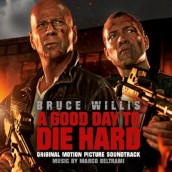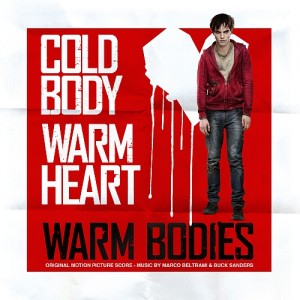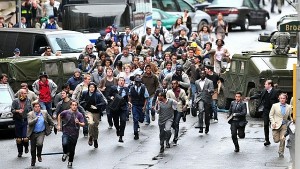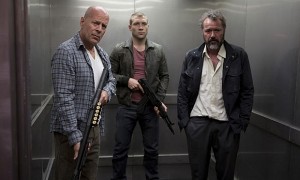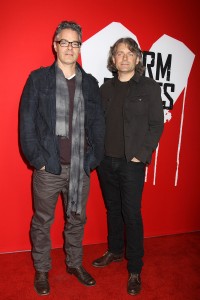If Marco Beltrami’s ever-growing resume of work makes him one of the hardest working composers in score business, then consider Buck Sanders as the session man who’s made the prolific number of IMDB entries possible (they currently have their work on display in the recent releases A GOOD DAY TO DIE HARD and WARM BODIES). After assisting Beltrami since the beginning of his career in roles ranging from synthesist to sound design, score producer and additional music writer for such stylistically diverse titles as THE MINUS MAN, I ROBOT and SOUL SURFER, Buck Sanders finally got to step into the spotlight in a very big way by sharing an Oscar nomination for co-composing the hauntingly offbeat, and intensely suspense score that filled THE HURT LOCKER‘s IED-filled war Iraqi war zone.
Sinister music has since pursued Beltrami and Sanders’ co-scoring efforts with the bad-ass cop heroics of MAX PAYNE and the under-the-bed horror that played the titular lie of DON’T BE AFRAID OF THE DARK. But if you’d be expecting a zombie holocaust to plunge the duo’s synergy into an utterly nightmarish realm, then WARM BODIES will no doubt provide a happy surprise, especially from the terror-soaked hands of Beltrami. Here the hipster high concept is following the blossoming humanization of an undead 20-something named R (Nicholas Hoult) and his unlikely romance with the spunky zombie-fighting Julie (Teresa Palmer). While Beltrami has often played the genre with a sense of quirk for the SCREAM series and HELLBOY, his teaming with Sanders turns those ghastly expectations on their head. Spaghetti western guitars playfully shamble with acid rock while Goblin-era synths get peppy with vibes usually heard during Hawaiian luaus, all to the tune of truly bizarre samples and percussion. Yet Beltrami and Sanders don’t flee from the scarier moments, or more importantly solid orchestrations for the film’s surprising emotional power, as their soundtrack’s eccentric flesh gradually grows a WARM emo-heart for a musical evolution that’s truly alt. enchanting.
But if you want throwback, then Marco Beltrami’s sole return to the ever-balding saga of John McClane will certainly give old school DIE HARD fans goosebumps with his second musical entry to the impossibly explosive franchise. For if LIVE FREE OR DIE HARD was more typically suspenseful in its action approach, Beltrami thankfully goes for a full-throttle Michael Kamen vibe for number five as McClane and Son make mincemeat out of Mother Russia’s villains. Sure this GOOD DAY might have a Soviet setting, but right from the snatch of “Ode To Joy.” Beltrami’s score is on flavorfully familiar territory, updating the unmistakable Kamen sound with militaristic, muscular orchestrations while retaining the same sense of over-the-top excess. For after a suspenseful set-up, this very GOOD score gives way to one roaringly melodic musical set-piece after the other, all with a fun Yippie Ki Yay Mother (expletive) rambunctiousness that Sanders was sure to have a hand in.
Now breathing slightly easier before the next onslaught of high-powered Hollywood titles hit them, Marco Beltrami and Buck Sanders reflect on a musical partnership that’s often proved that death can be a very creatively productive thing to play- no more so than this month.
ASSIGNMENT X: Marco, how did you and Buck first team up?
SANDERS: I worked at a now-closed laser disc store in Los Angeles called Laser Blazer. Steve Harris, who used to work there, produced a CD of Marco’s score to LAND’S END, which I helped with the layout for. Marco also mentioned to Steve that he was looking for help in his studio, especially as he was at wit’s end with MIMIC. So I rang his doorbell. Marco appears, and was completely disheveled. He handed me money to go out and do some errands. He didn’t even ask who I was! Marco just figured “This has to be Buck, though I could have been anybody. Marco doesn’t have a strong affection for computers or electronics, or anything like that. He saw that I was very interested it, so I basically ran with that. We seemed to really click, and that was nearly 15 years ago.
BELTRAMI: I think we work well together, and compliment each other’s strengths. My best work comes from collaborative projects like this.
AX: How did your collaboration work on WARM BODIES?
SANDERS: I’ve collaborated pretty strongly on pretty much every film that Marco has done in slightly different roles each time, much like a record producer would. Once we saw what direction WARM BODIES would take, we treated it almost like an indie rock production, which made this score a particular joy to work on. We looked forward to it everyday, even with all the changes the film went through.
AX: I can imagine with all the different tones the film has in it. How difficult was it to find the direction for WARM BODIES because of that?
BELTRAMI: It took a little bit of searching. We were playing around with different ideas. Buck has this idea that the score for the beginning of would almost be like a broken record going around and around. I was working on some thematic ideas for the growing relationship between R and Julie.
SANDERS: R is a bit of a hoarder. He collects a lot of stuff, particularly vinyl records. One of the first ideas we started exploring was the sound a record makes when the needle get to the end of a side. You could call it a “clicking” loop. That became the basis for a lot of the rhythm in the score. We’d also transcribe that idea to other instruments. I ended up sampling every one of my vinyl albums in the process. It was really cool to discover that each record has its own personality and rhythm.
AX: So vinyl lives in a zombie film?
SANDERS: Yes.
AX: Most horror films are about de-evolution, i.e. the characters turning into inhuman zombies, werewolves or other creatures. What’s interesting is that the high concept here is that it’s about a zombie who regains his humanity. How do you think that factors into the score?
BELTRAMI: We started out with a lot of non-real instruments and things that were heavily processed. We also incorporated vintage synthesizers as the score progressed until it finally becomes more symphonic in a way, although we never used a huge orchestra. It’s done in a more realistic, and thematic way.
SANDERS: One of the other things we did was to process the guitars sampling the sounds as if they were “decomposing” like the zombies. The guitars matched the vibe of all the songs that Jonathan had set up in the film. We didn’t want the score to feel foreign to that vibe. Our music editor had also put a lot of Marco’s score for 3:10 TO YUMA into the temporary soundtrack, which had an organic western feel to it. That contributed to the “Italian” feel of the ultimate score as well.
AX: Marco, the “spaghetti western” sound of YUMA and THE THREE BURIALS OF MELQUIADES ESTRADA has certainly give you some of you’re your most interesting, and stranger experiments in percussion.
BELTRAMI: The thing about the landscape of zombies is that you can afford to be a little bit “out there” with your sounds. Here it’s also the fact that WARM BODIES is not a “horror” movie as such, though there are some scary moments in it. So you can afford to be playful in many ways. However, straight “horror” scores are refreshing because you’re not constrained by the kind of music that might normally draw the listener out of the experience. Here, I think that hybrid sound reinforces the kind of strange world that these characters inhabit.
SANDERS: We definitely reached into familiar territory with manipulating strings with effects you would find in a horror score. I think having that bridge of a spaghetti western approach really helped form the score’s sound. Spaghetti westerns in general had the kind of quirky quality we could pursue through the score, especially with this being a zombie film that was cutesy and romantic cutesy. But it still veers off into more intense moments, which made it such a fun film to work on.
AX: Marco, your career started with SCREAM, which was a horror parody that was also bloody serious. How would you describe Warm Bodies in terms of mixing satire with scares?
BELTRAMI: The thing about WARM BODIES is that it’s really original material. SCREAM is original in a different way in how it makes fun of other horror movies. WARM BODIES has the awareness of its audiences’ preoccupation with zombie movies, and the zombies’ behavior in them. That makes scoring this easier for me, because the place I do my best is when I can mix and play around with musical genres.
AX: WARM BODIES’ director and co-writer is Jonathan Levine (THE WACKNESS / 50 / 50), who got started with the slasher satire ALL THE BOYS LOVE MANDY LANE, which still has yet to get released here. How do you think that quirky attitude plays into the zombie genre?
SANDERS: I think Jonathan’s one of those directors that really wants to explore a bunch of different genres. He’s like James Mangold, in how that director could jump from IDENTITY into YUMA. I think Jonathan really enjoys the challenge of being put into new environments. Musically he’s the same way. What’s also great is that he’s a very open and trusting director. He sort of lets you just run with it, but would also let us know if something wasn’t resonating with him. Overall working with him on WARM BODIES was a very easy process.
AX: You have the epic WORD WAR Z coming up after this. How difficult will it be segueing from a very lighthearted zombie film into something that’s more hard-core?
BELTRAMI: I think that WORLD WAR Z will be a completely different type of score, one that will be very aggressive. That’s more of a story of humanity facing an apocalypse, which is certainly darker than WARM BODIES take on the material. Again, it’s a great way for me to switch gears. In that way, I think there are few genres that don’t suit me, especially when the same ones can offer different challenges.
AX: A GOOD DAY TO DIE HARD is your second time up at bat with the character of John McClane. It also seems that there’s a lot more bold action music going on with this score.
BELTRAMI: This film is a freight train. It starts and it doesn’t let go. But if the score sounds like that to you, then I think that comes from the fact that I’ve done four movies with the director John Moore, including FLIGHT OF THE PHOENIX, THE OMEN and MAX PAYNE. with Buck. So I sort of get him as person. We also had very little time to score this movie, about six weeks, which made us write it like a freight train as well. Another difference is that this soundtrack identifies with the past Michael Kamen DIE HARD scores, while functioning as its own thing as well. Buck created a lot of the rhythmic settings for the orchestra to play with. Also because the nature of the quick turn around, Marcus Trump and Brandon Roberts really helped with the programming as well. They were still filming as we were working on it, doing additional scenes even as the sessions were going on. Drastic new cuts were arriving. While there are 80 minutes of score in the movie, we actually ended up writing over two hours of music before it was all approved because of the new cuts. It was a whirlwind of a score.
DS: What do you think the big musical differences are between Len Wiseman, who directed LIVE FREE OR DIE HARD, and John Moore’s on A GOOD DAY TO DIE HARD?
BELTRAMI: John had a vision of really hearkening back to a late 70’s early 80’s feel. He referenced Lalo Schifrin a bunch. Rather then shying away from some of action music that people view as clichés, like score that used horns, muted brass and triangles and bongos, we really had a lot of fun embracing that stuff. It’s the type of score that doesn’t take itself seriously. It’s not a “real world” type of action movie score.
AX: Fans are really going to be delighted by all of the Michael Kamen references in it, including his use of Mozart’s “Ode To Joy.” Did you study Michael’s past scores to nail his style?
BELTRAMI: There’s a harmony that Michael used a lot in his scores. He loves these minor 9th chords. Picking up on some of the harmonic and motivic influences is enough to give us that language. But rhythmically, GOOD DAY has a very different spirit then Kamen’s scores. Most of this is in odd meters, like seven and 9/8ths rhythms. You could say this has a more “modern” approach.
SANDERS: When you start adding in those little Kamen rhythms to the “modern” score, it really blossomed into a DIE HARD soundtrack. Like Marco said, there’s a ton of weight to GOOD DAY. But as soon as you have those little musical reminiscences, it lifts some of that weight off and makes the score come alive. It was a really interesting process to watch it develop.
BELTRAMI: Any action score that uses a harmonica and bongos adds a certain levity to it, you know?
AX: How “Russian” did you wanted this score to be?
BELTRAMI: A little flavor goes a long way, which was a line that we were conscious of all the time. We used some Balalaika and some dulcimer, while always wondering if we were going too far. You want to add a little bit of that “Russian” character without dragging it to far into that world.
AX: The score also reflects the military nature of the bad guys.
BELTRAMI: That’s definitely a part of it between the villains and having John McClane’s son is in the CIA. We were actually on the scoring stage when John Moore remarked how the sound of the Russian military drums were quite a bit different from American ones, which made us fool around quite a bit with getting the sound right on the percussion.
AX: There’s a particularly neat cue called “McClane’s Brain,” which has a crazed jazz-percussion sound that’s unlike anything else in the score.
BELTRAMI: One of the ways we worked on this score was to have a bunch of musicians come out to the studio, including a Balalaika, harmonica and saxophone players. We wrote things out that we wanted to sample, as well as music that would become an integral part of the score. We started to jam on some of the ideas, and ended up with this completely spontaneous cue. In fact, I didn’t even play it for John Moore because it was so unlike the rest of the score. I waited until the very last day of recording, and he’s like, “What’s this?” He was digging it so much that we had to find a place for “McClane’s Brain.” It only exists in the end credit suite, but it definitely was a fun piece to do.
AX: Do you think that A GOOD DAY TO DIE HARD is overall a much more fun movie and score to work on then the last time out?
BELTRAMI: I don’t want to compare movies, but this “Die Hard” was definitely a really fun time. I love working for John because his wit is so quick.
SANDERS: There’s nobody more passionate then John Moore.
BELTRAMI: I can write something and if John makes comments about it you feel inspired to try something. You’re always eager to try new things because he’s pushing you. Something will click with him. He’ll hear it and it will inspire him, which in turn inspires you.
- Snowpiercer ©2013 The Weinstein Company
AX: I’m really looking forward to hearing what the sound for the apocalyptic sci-fi movie SNOWPIERCER will be.
BELTRAMI: SNOWPIERCER is pretty much done. We just have to record it. I scored it for another brilliant director named Joon-ho Bong, who did the monster movie THE HOST. This movie is completely different though. Because the whole thing takes place on a train, Buck created a lot of textures that make musical identities out of train sounds. There’s also a strong orchestral element to SNOWPIERCER‘s score as well. It’s a real musical hybrid.
AX: Marco, if I had to compare you to a character, it would be McClane’s son. You’re the guy picking up from the old school, taking the sound of old classics like THE OMEN, CARRIE and DIE HARD in a new direction. How scary, and challenging is that?
BELTRAMI: The source of my anxiety and insomnia is that I’m not sure how to do it, because we’re figuring this stuff out as we go. I don’t think there’s a conscious attempt to reinvent the musical wheel. It’s just what feels right for the score, and how that’s reflected by whatever background and influences you have as a composer. The stuff just comes out of you, and you just try to do the best for the picture. So I don’t think there’s a specific goal in mind here. I always feel like we’re flying by the seat of our pants.
AX: Why do you think you guys work so well together?
BELTRAMI: I think it’s a really symbiotic relationship. In some ways, I think I’m much more emotional and impulsive, which I think sometimes works. You need that spark, but it also can get you into trouble. Buck is more intellectual about things, so having this sort of system of musical checks and balances works where we come up with ideas and cues together. Buck and I are able to achieve a lot of new ground being able to bounce ideas off of each other and work in tandem to contribute to each other’s strengths. It started out as him being more of an assistant. But at this point, I think we’re kind of like partners in the music score. We’re able to achieve a lot more because of our experiences together, and that’s a rare kind of relationship. I don’t know how many other composers have this, but I find that it’s really successful for both of us.
Special thanks to Peter Hackman for transcribing this interview
Clink on the link to buy the A GOOD DAY TO DIE HARD soundtrack
Clink on the link to visit Marco Beltrami’s website
Follow us on Twitter at ASSIGNMENT X
Fan us on Facebook at ASSIGNMENTX
Article Source: Assignment X
Article:Interview with A GOOD DAY TO DIE HARD and WARM BODIES composers Marco Beltrami and Buck Sanders
Related Posts:




